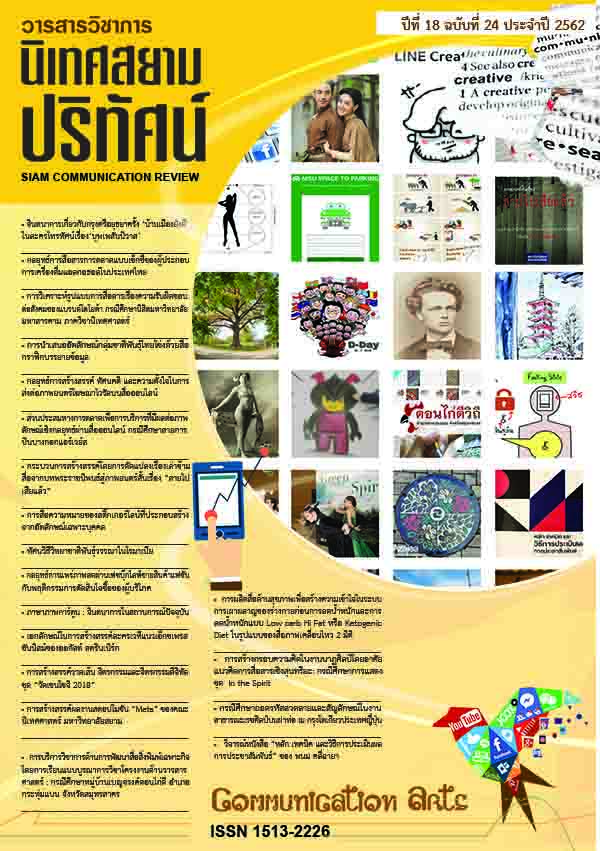Creative Strategies, Attitudes and Intentions to Share Viral Online Advertising Videos
Main Article Content
Abstract
The objectives of this research were to study (1) strategies used to create viral online video advertisements; (2) strategies to disseminate viral online advertisements; (3) the attitudes of online message receivers in Bangkok about viral online video advertisements and their intentions in sharing them; (4) factors that made people share online advertisements; and (5) the relationships between demographic factors and people’s attitudes about and intention to share online advertisements. This was a mixed methods research. For the qualitative portion, the key informants were 6 creators of online advertisement videos, chosen from among people with work experience of 5 or more years in the video advertisement creation business. The research tool was an interview form and data were analyzed through descriptive analysis. For the quantitative portion, the sample population was 400 residents of Bangkok aged 18 and over, chosen through multi-stage sampling. The research tool was a questionnaire. Data were analyzed using frequency, percentage, mean, standard deviation, Scheffe’s test, t test and ANOVA. The results showed that (1) online advertisement creators considered video content the most important. They used presentation strategies of eliciting an emotional response and appealing to viewers’ empathy. (2) To be suitable, online video ads should be 3-5 minutes long. The ad companies used dissemination strategies of promoting the video, starting a discussion and arousing curiosity. (3) As for their attitudes about viral online video advertisements, the majority of the samples gave a very high approval rating for video content, presentation methods, dissemination and methods. (4) The social factor that influenced the samples’ choices to share the videos the most was friends. (5) The demographic factor of educational level was related to attitude about online video advertisement creation strategies and video content. The factors of age group and educational level were related to attitude about online video advertisement creation strategies and presentation methods. The factors of gender, age group, educational level and occupation were related to attitude about sharing viral online video advertisements. The factors of gender, age group, and educational level were related to attitude about intention to share viral online video advertisements.
Article Details
References
ณัฐชนา สุรดินทร์. (2559). “ทัศนคติของผู้บริโภคต่อ Viral Video Online” ที่มีโฆษณาแฝงและไม่มีโฆษณาแฝง. การค้นคว้าอิสระปริญญามหาบัณฑิต มหาวิทยาลัยธรรมศาสตร์.
บุญชม ศรีสะอาด. (2543). การวิจัยเบื้องต้น (พิมพ์ครั้งที่ 6). กรุงเทพฯ: สุวีริยาสานส์น.
ปรเมษฐ์ กฤตลักษณ์. (2553). อิทธิพลของการตลาดนอกกรอบและหมวก 6 ใบคิด 6 แบบ ต่อกระบวนการสร้างสรรค์และความสำเร็จของนักสร้างสรรค์โฆษณา. วิทยานิพนธ์ปริญญาดุษฎีบัณฑิต มหาวิทยาลัยปทุมธานี.
พรทิพย์ สัมปัตตะวนิช. (2546). แรงจูงใจในการโฆษณา. กรุงเทพฯ: มหาวิทยาลัยธรรมศาสตร์.
ภพพรหมินทร์ วโรตม์วัฒนานนท์. (2558). ปัจจัยที่มีอิทธิพลต่อการสื่อสารแบบปากต่อปากในยุคดิจิทัล. วารสารการสื่อสารและการจัดการ นิด้า, 1(1), 86-100.
วิน รัตนาธีราธร. (2553). ทัศนคติต่อการทำการสื่อสารทางการตลาดในรูปแบบ viral video และปัจจัยที่มีผลต่อการตัดสินใจแชร์ออนไลน์วิดีโอ ของผู้ใช้ Facebook ในเขตกรุงเทพมหานคร. การค้นคว้าอิสระปริญญามหาบัณฑิต มหาวิทยาลัยธรรมศาสตร์.
เสรี วงษ์มณฑา. (2535). เคล็ด (ไม่) ลับจอมยุทธ์การตลาดและโฆษณา. นนทบุรี: สำนักบรรณสารสนเทศมหาวิทยาลัยสุโขทัยธรรมาธิราช.
ภาษาอังกฤษ
Bajpai, V., & Pandey, S. (2012). Viral marketing through Social network sites with special reference of facebook. Jornal of Marketing, 1(7), 194-207.
Christopher P. Puto and William D. Wells. (1984), Informational and Transformational Advertising: the Differential Effects of Time. Advances in Consumer Research, 11, (638-643).
Kirby, J., & Marsden, P. (Eds.). (2006). Connected Marketing: The Viral, Buzz and Word of Mouth Revolution. Oxford: Elsevier.
William, C.S. (1996). FIRO: A Three Dimensional Theory of Interpersonal Behavior. New York: Holt, Rinehart, & Winston.
ออนไลน์
นุชฤดี ลุ่ยใหม่. (2558). ไวรัสระบาดในตลาดผ่านโซเชียลมีเดีย. เข้าถึงได้จาก http://www.mktevent.com
มาริสา อานิต้า ฟันเดอรวาวเดอะ. (2557). ปัจจัยที่ก่อให้เกิดการแบ่งปันวิดีโอคลิปสำหรับการตลาดแบบไวรัล (Viral Marketing) โดยใช้สื่อเครือข่ายสังคมออนไลน์. เข้าถึงได้จาก https://repository.nida.ac.th/handle/662723737/3338
สถาบันวิจัยประชากรและสังคม. (2556). จำนวนประชากรในกรุงเทพมหานคร. เข้าถึงได้จาก http://www.ipsr.mahidol.ac.th/ipsrbeta/th/Contact.aspx.
สุนิสา ตั้งเขื่อนขันธ์. (2547). ทฤษฎี แนวคิดและงานวิจัยที่เกี่ยวข้อง. เข้าถึงได้จากhttp://mslib.kku.ac.th/elib/multim/books/Marketing2555/PANURIT%20SARASOMBAT/05_ch2.pdf
Tana Social Media. (2016). เผยสถิติการใช้ Internet และ Social Media ล่าสุด: ประเทศไทยไม่น้อยหน้าชาติใดในโลก. เข้าถึงได้จาก http://www.9tana.com/node/thailand-social-stat-2016/


